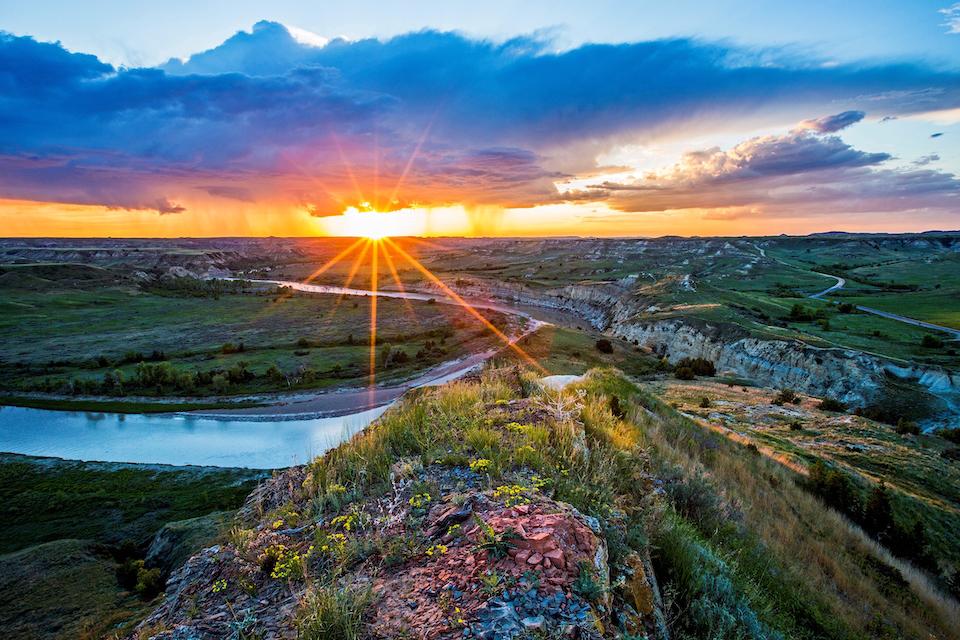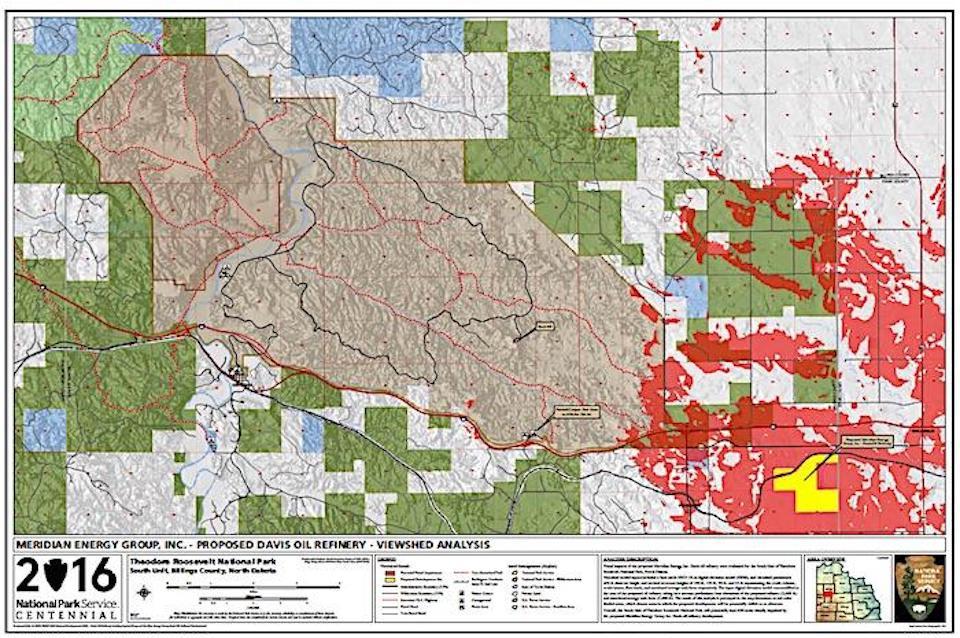
An oil refinery that opponents fear could sully the air quality of Theodore Roosevelt National Park has cleared a legal hurdle as it moves closer to final approval/NPS, Dave Bruner
A state district court has upheld a decision by the North Dakota Department of Health to permit an oil refinery a small handful of miles from the main entrance to Theodore Roosevelt National Park.
Principals for Meridian Energy, which wants to build the Davis Refinery about three miles from the park's South Unit entrance, maintain that it would be the cleanest refinery ever built in the United States. They say the state-of-the-art facility would be located on 620 acres of land east of Theodore Roosevelt, between Fryburg and Belfield. The location is adjacent to a BNSF rail loading facility at Fryburg; the rail line actually runs through the refinery site.
As envisioned, the refinery would be supported by a mix of residential and commercial development that opponents maintain would dwarf most, if not all, towns in southwestern North Dakota, and potentially could impact the national park's air quality, soundscape, and viewshed.
In a lawsuit challenging the permit the Health Department issued last year, the Dakota Resource Council, Environmental Law & Policy Center, and National Parks Conservation Association opposed the state’s classification of the industrial refinery as a “minor” source of pollution rather than as a “major” source. The permit granted by North Dakota does not provide needed assurances that Meridian Energy will keep pollution to required levels, they argue.
But District Judge Dann Greenwood dismissed those concerns in his 26-page ruling (attached below) handed down this week. The judge acknowledged that he was not an expert in pollution controls and was "not capable of articulating why certain parts of the record either support or detract from one side of the issue or the other in this case," but he was confident the state agency was competent in managing the permitting for a refinery capable of producing 55,000 barrels of fuel products per day.
"From a review of (the Health Department's) responses to comments and its brief ... it appears that NDDOH has both acknowledged an appreciation of the requirements of the law and demonstrated that the permit and the conditions set forth therein satisfy applicable regulations," Judge Greenwood wrote.
National Park Service officials, most of whom have been furloughed during the ongoing partial government shutdown, could not be reached Thursday for comment. In the past, Theodore Roosevelt Superintendent Wendy Ross has said the refinery would "forever change the visitor experience in the South Unit."

National Park Service officials created this map to show how visible the proposed Davis Refinery would be from Theodore Roosevelt National Park. The refinery would be visible from park areas marked in red, according to the NPS. The park is the tan colored area.
At NPCA, officials were mulling their options for continuing the battle against the refinery.
The plaintiffs had argued that the air permit granted Meridian fails to provide adequate limits for the refinery’s pollution and doesn’t adequately monitor pollutants as necessary to protect local air quality. Following the judge's ruling, they said he "ignored problems with the permit and neglected North Dakota citizens and visitors need for clean air."
“The court ruling effectively gives a green light for the Davis Refinery to pollute the air at Theodore Roosevelt National Park and surrounding communities,” said Stephanie Kodish, NPCA's clean air program director. “North Dakota Department of Health needs to be held accountable for issuing a weak permit and allowing the Davis refinery to continue as planned.”
At the Environmental Law & Policy Center, attorney Scott Strand said "the record is clear that the Department of Health knew that Meridian’s permit application was not credible, but let it go anyway."



Comments
I cannot believe this could happen for the greed of money for the oil refinery. That is an absolutely beautiful park, and no one wants to see something like that when they are driving around, or enjoying the National Park, or have air pollution in it, when they travel to a National Park. Especially when they can build it somewhere else. I saw the news on Good Morning America this morning, and researched it, so this is how I got to this site. We took our family to this National Park in 2007, when our kids were young, and it was absolutely gorgeous! This is a disgrace!
I'm kind of torn when something like this comes up. I understand that you have a national park. But then you have what's outside of a national park that is ostensibly governed differently. I live in an area with a lot of refineries. The Chevron Richmond refinery is clearly visible from parts of Rosie the Riveter WWII Home Front National Historical Park. There are two refineries in Martinez, California, and both are visible from John Muir National Historic Site.
Sometimes I don't get the rationale that what goes on outside of a national park is the purview of NPS. When there were plans to put up a cell phone tower in Gardiner, Montana (just outside the NW entrance of Yellowstone) NPS complained that a large modern structure would detract from Roosevelt Arch. Even though the Gardiner HS football field was 500 ft away.
The article fails to include the opponents' evidence that the facility should have been classified as a "major" source or in what aspects the proposed project would fail to meet the requirements of the law. What did the opponents' chemical engineer find that the NDDOH engineer did not?
As a former NPS employee and major source air permitting engineer, I can confidently say that project opponents oppose projects on the basis of what they wish the laws and standards should be instead of what the laws and standards are.
Additionally, page 10 of the court's decision states "comments made by the National Park Service and the EPA did not question NDDOH's determination that the refinery qualified as a synthetic minor source based upon its potential to emit, but merely sought clarification on certain items in the permit."
"I cannot believe this could happen for the greed of money for the oil refinery. That is an absolutely beautiful park, and no one wants to see something like that when they are driving around, or enjoying the National Park, or have air pollution in it,"
You dont want an oil refinery or pollution but yet you want to keep "driving around" ?
That's funny, Wild, but also sad in the frequency we see such hypocracy. Rita and Y-P-W's (a pleasant surprise) comments are also spot on.
All they need to do is look at the awful impact of the Bakken shale industries off the North Unit of Teddy Roosevelt NP to see how adverse the effect is on the National Park values.